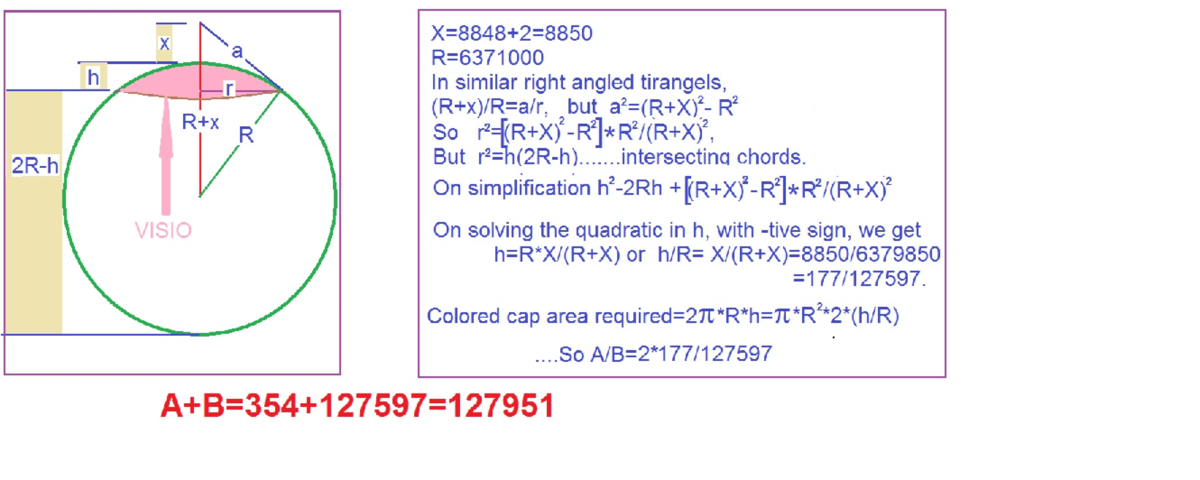How Vast Is Your Vision?
A man with eye-to-ground height 2 meters is standing on top of Mt. Everest which is 8,848 meters high. Suppose also that Mt. Everest was "relocated" on a point in the Pacific Ocean where there are no mountains, no islands, no clouds, just the plain ocean in sight.
The spherical surface area enclosed by the horizon (neglecting the presence of the mountain) as seen by the man can be expressed in the form where and are coprime positive integers , and is the radius of the Earth (assumed to be a perfect sphere with ).
Find .
Note : Assume also that the man has a maximized vision.
The answer is 127951.
This section requires Javascript.
You are seeing this because something didn't load right. We suggest you, (a) try
refreshing the page, (b) enabling javascript if it is disabled on your browser and,
finally, (c)
loading the
non-javascript version of this page
. We're sorry about the hassle.

Let us assume the scenario to be like this.
The line of sight of the man, assuming perfectly ideal vision, will be perpendicular to the surface of the Earth, as the horizon serves as its point of tangency.
Thus, the line of sight of the man in all directions define the set of points tangent to the sphere (which we perceive as the horizon), which will be a spherical cap whose edge is perpendicular to the straight eye level line of sight of the man. The area enclosed by this is depicted in the figure.
The area of a spherical cap may be derived by using the formula for surface area integrals for sphere sections. From there, we will use this
S = 2 π R 2 ( 1 − c o s θ ) ..
If we cut this planet crosswise, we will be able to visualize this.
Now, we can easily get θ by using the general ratio for right triangles (remember that the line of sight is perpendicular to a radius of a sphere). This gives us
c o s θ = R + h R
where h represents the combined height of the mountain and the man's eye to ground level.
From this we can simplify the formula for S .
S = 2 π R 2 ( 1 − R + h R )
S = 2 π R 2 ( R + h h )
which means we only need to find out
2 ( R + h h )
given h = 8 . 8 5 km, and R = 6 3 7 1 km, we find the ratio to be
6 3 7 9 . 8 5 1 7 . 7 0 = 1 2 7 5 9 7 3 5 4
That will ultimately give us 3 5 4 + 1 2 7 5 9 7 = 1 2 7 9 5 1 .
Sorry for the poor drawings.
A = 2 π ∫ r − h r x 1 + ( y ′ ) 2 d x
and got A = 2 π R h
well the h here had nothing to do with the variable h mentioned and used above. h here refers to the maximum height of the spherical cap. Well, h here is equal to R − R c o s θ . That just justifies the formula used above.